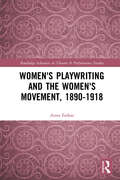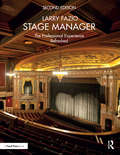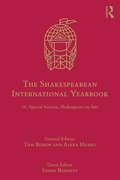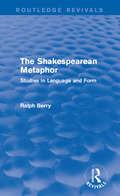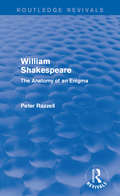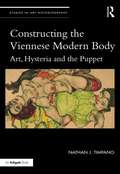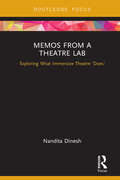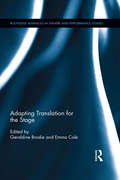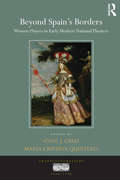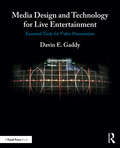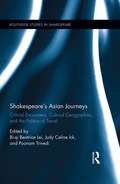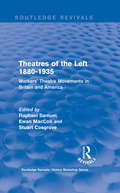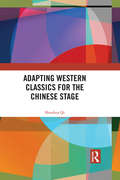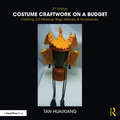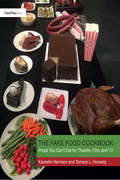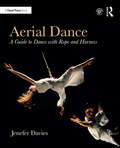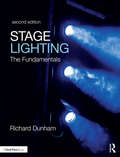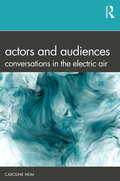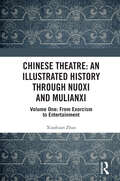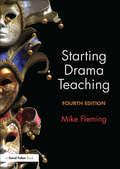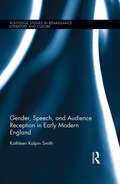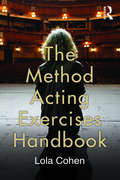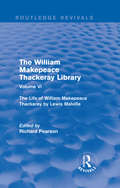- Table View
- List View
Women's Playwriting and the Women's Movement, 1890-1918 (Routledge Advances in Theatre & Performance Studies)
by Anna FarkasThe influence of the women’s movement has long been a scholarly priority in the study of British women’s drama of the late nineteenth and early twentieth centuries, but previous scholarship has largely clustered around two events: the New Woman in the 1890s and the suffrage campaign in the years before the First World War. Women’s Playwriting and the Women’s Movement, 1890–1918 is the first designated study of British women’s drama from a period of exceptional productivity and innovation for female playwrights. Both the British theatre and women’s position within British society underwent fundamental changes in this period, and this book shows how female dramatists carefully negotiated their position in the heated debates about women’s rights that occurred at this time, while staking out a place for themselves in an evolving theatrical landscape. Farkas also identifies the women’s movement as a key influence on the development of female-authored drama between 1890 and 1918, but argues that scholarly prioritizing of the "radicalism" of work associated with the New Woman and the suffrage campaign has had a distorting effect in the past. Ideal for scholars of British and Victorian theatre, Women’s Playwriting and the Women’s Movement, 1890–1918 offers a new perspective which emphasizes the complexity of women playwrights’ engagement with first-wave feminism and links it to the diversification of the British theatre in this period.
Stage Manager: The Professional Experience—Refreshed
by Larry FazioStage Manager: The Professional Experience–Refreshed takes the reader on a journey through all aspects of the craft of stage management in theatre, including the technological advancements that have come to theatre and the stage manger’s job. Chapters are laid out to reflect the order in which stage managers experience and perform their work: what makes a good stage manager, seeking the job, building a resume, interviewing for the job, and getting the job (or not getting the job). Included are chapters on the chain of command, working relationships, tool and supplies, creating charts, plots, plans and lists, the rehearsal period, creating the prompt book, calling cues, and the run of the show. These are just some of the many topics covered in this book. In addition, the author uses interviews with stage management professionals in various stages of production, providing another view of how the stage manager is perceived and what is expected form the work of the stage manager. Fifteen years after the original publication of Stage Manager: The Professional Experience, this new and refreshed edition is now in color to help clarify and illustrate points in the text. It is fully updated to reflect the the world of computerized technology: smart phones, thinly designed laptops, tablets, use of email and text messaging, storing and sharing files and information in cloud-based apps. Then there are the innovations of automation–electronically moving scenery, scenic projections–casting images and patterns on the stage; moving lights; LED luminaires; lasers; and greater use of fog and haze machines. In addition, the extensive glossary of more than 600 terms and phrases had been extend to well over 700, providing and excellent professional vocabulary for anyone hoping to be a theatre stage manager or already working in the field.
The Shakespearean International Yearbook: 16: Special Section, Shakespeare on Site (The Shakespearean International Yearbook)
by Alexa Huang Tom BishopShakespearean performances regularly take place at both historic sites and locations with complex resonances, such as Shakespeare’s Globe Theatre in London and the royal castle of Hamlet – Elsinore – in Denmark. The present issue of the Shakespeare International Yearbook examines the impact of specificities such as festivals and performance sites on our understanding of Shakespeare and globalization. Contributions survey the present state of Shakespeare studies and address issues that are fundamental to our interpretive encounter with Shakespeare's work and his time, across the whole spectrum of his literary output.
Routledge Revivals (1990): Studies in Language and Form
by Ralph BerryFirst published in 1978, this book represents a study of the ways in which Shakespeare exploits the possibilities of metaphor. In a series of studies ranging from the early to the mature Shakespeare, the author concentrates on metaphor as a controlling structure — the extent to which a certain metaphoric idea informs and organises the drama. These studies turn constantly to the relations between symbol and metaphor, literal and figurative, and examine key plays such as Richard III, King John, Henry V, Romeo and Juliet, Troilus and Cressida, and Coriolanus. They also provide a key to The Tempest which is analysed in terms of power and possession — the dominant motif.
Routledge Revivals (1990): The Anatomy of an Enigma
by P. E. RazzellFirst published in 1990, the aim of this book is to reveal the William Shakespeare whose life has been obscured by centuries of literary mythology. It unravels a series of strands in order to understand the man and the major influences which shaped his life and writing. The first part advances the thesis that his relationship with his father directly influenced the character of Falstaff — helping to not only explain key events in his father’s life but also critical events in his own biography. This thesis not only illuminates the Falstaff plays but also a number of other works such as Hamlet. The second part focuses on Shakespeare’s own life, and includes much original research particularly on the tradition that he was a poacher of deer, discussing the influence this incident had on his later life and writings. In addition, a sociological approach has been used which illuminates a number of key areas, including questioning the view his background was narrow and provincial — which has often been used to dispute his authorship of plays of such cosmopolitan appeal.
Constructing the Viennese Modern Body: Art, Hysteria, and the Puppet (Studies in Art Historiography)
by Nathan J. TimpanoThis book takes a new, interdisciplinary approach to analyzing modern Viennese visual culture, one informed by Austro-German theater, contemporary medical treatises centered on hysteria, and an original examination of dramatic gestures in expressionist artworks. It centers on the following question: How and to what end was the human body discussed, portrayed, and utilized as an aesthetic metaphor in turn-of-the-century Vienna? By scrutinizing theatrically “hysterical” performances, avant-garde puppet plays, and images created by Oskar Kokoschka, Koloman Moser, Egon Schiele and others, Nathan J. Timpano discusses how Viennese artists favored the pathological or puppet-like body as their contribution to European modernism.
Memos from a Theatre Lab: Exploring what immersive theatre 'does' (Series In Performing Arts Ser.)
by Nandita DineshWhat does Immersive Theatre ‘do’? By contrasting two specific performances on the same theme – one an ‘immersive’ experience and the other a more conventional theatrical production – Nandita Dinesh explores the ways in which theatrical form impacts upon actors and audiences. An in-depth case study of her work Pinjare (Cages) sets out the ‘hows’ and ‘whys’ of her specific aesthetic framework. Memos from a Theatre Lab places Dinesh’s practical work within the context of existing analyses of Immersive Theatre, using this investigation to generate an underpinning theory of how Immersive Theatre works for its participants.
Adapting Translation for the Stage (Routledge Advances in Theatre & Performance Studies)
by Geraldine Brodie Emma ColeTranslating for performance is a difficult – and hotly contested – activity. Adapting Translation for the Stage presents a sustained dialogue between scholars, actors, directors, writers, and those working across these boundaries, exploring common themes and issues encountered when writing, staging, and researching translated works. It is organised into four parts, each reflecting on a theatrical genre where translation is regularly practised: The Role of Translation in Rewriting Naturalist Theatre Adapting Classical Drama at the Turn of the Twenty-First Century Translocating Political Activism in Contemporary Theatre Modernist Narratives of Translation in Performance A range of case studies from the National Theatre’s Medea to The Gate Theatre’s Dances of Death and Emily Mann’s The House of Bernarda Alba shed new light on the creative processes inherent in translating for the theatre, destabilising the literal/performable binary to suggest that adaptation and translation can – and do – coexist on stage. Chronicling the many possible intersections between translation theory and practice, Adapting Translation for the Stage offers a unique exploration of the processes of translating, adapting, and relocating work for the theatre.
Beyond Spain's Borders: Women Players in Early Modern National Theaters (Transculturalisms, 1400-1700)
by Anne J. Cruz María Cristina QuinteroThe prolific theatrical activity that abounded on the stages of early modern Europe demonstrates that drama was a genre that transcended national borders. The transnational character of early modern theater reflects the rich admixture of various dramatic traditions, such as Spain’s comedia and Italy’s commedia dell’arte, but also the transformations across cultures of Spanish novellas to French plays and English interludes. Of particular import to this study is the role that women and gender played in this cross-pollination of theatrical sources and practices. Contributors to the volume not only investigate the gendered effect of Spanish texts and literary types on English and French drama, they address the actual journeys of Spanish actresses to French theaters and of Italian actresses to the Spanish stage, while several emphasize the movement of royal women to various courts and their impact on theatrical activity in Spain and abroad. In their innovative focus on women’s participation and influence, the chapters in this volume illustrate the frequent yet little studied transnational and transcultural points of contact between Spanish theater and the national theaters of England, France, Austria, and Italy.
Media Design and Technology for Live Entertainment: Essential Tools for Video Presentation
by Davin GaddyMedia Design and Technology for Live Entertainment is a guide to understanding the concepts and equipment used in projection and video design for live performances. After an introduction in the principles of design elements as well as information on content, this book focuses on how content is used and transmitted by describing the essential components of systems, providing definitions used in communicating video concepts, and including basic system troubleshooting tips and tricks. A brief history of projected imagery is included, as well as information on analog systems, as outdated technology continues to be used either by choice of the designer or by necessity due to budget. By providing the information to understand the tools and how to use them, the reader should be able to create their own systems to meet his or her design ideas.
Shakespeare’s Asian Journeys: Critical Encounters, Cultural Geographies, and the Politics of Travel (Routledge Studies in Shakespeare)
by Bi-qi Beatrice Lei Judy Celine Ick Poonam TrivediThis volume gives Asia’s Shakespeares the critical, theoretical, and political space they demand, offering rich, alternative ways of thinking about Asia, Shakespeare, and Asian Shakespeare based on Asian experiences and histories. Challenging and supplementing the dominant critical and theoretical structures that determine Shakespeare studies today, close analysis of Shakespeare’s Asian journeys, critical encounters, cultural geographies, and the political complexions of these negotiations reveal perspectives different to the European. Exploring what Shakespeare has done to Asia along with what Asia has done with Shakespeare, this book demonstrates how Shakespeare helps articulate Asianess, unfolding Asia’s past, reflecting Asia’s present, and projecting Asia’s future. This is achieved by forgoing the myth of the Bard’s universality, bypassing the authenticity test, avoiding merely descriptive or even ethnographic accounts, and using caution when applying Western theoretical frameworks. Many of the productions studied in this volume are brought to critical attention for the first time, offering new methodologies and approaches across disciplines including history, philosophy, sociology, geopolitics, religion, postcolonial studies, psychology, translation theory, film studies, and others. The volume explores a range of examples, from exquisite productions infused with ancient aesthetic traditions to popular teen manga and television drama, from state-dictated appropriations to radical political commentaries in areas including Japan, India, Taiwan, Korea, Indonesia, China, and the Philippines. This book goes beyond a showcasing of Asian adaptations in various languages, styles, and theatre traditions, and beyond introductory essays intended to help an unknowing audience appreciate Asian performances, developing a more inflected interpretative dialogue with other areas of Shakespeare studies.
Routledge Revivals: Workers' Theatre Movements in Britain and America (Routledge Revivals: History Workshop Series #5)
by Raphael Samuel Stuart Cosgrove Ewan MaccollFirst published in 1985, this book examines how workers theatre movements intended their performances to be activist — perceiving art as a weapon of struggle and enlightenment — and an emancipatory act. An introductory study relates left-wing theatre groupings to the cultural narratives of contemporary British socialism. The progress of the Workers’ Theatre Movement (1928-1935) is traced from simple realism to the most brilliant phase of its Russian and German development alongside which the parallel movements in the United States are also examined. A number of crucial texts are reprints as well as stage notes and glimpses of the dramaturgical controversies which accompanied them.
Adapting Western Classics for the Chinese Stage
by Shouhua QiAdapting Western Classics for the Chinese Stage presents a comprehensive study of transnational, transcultural, and translingual adaptations of Western classics from the turn of the twentieth century to present-day China in the age of globalization. Supported by a wide range of in-depth research, this book Examines the complex dynamics between texts, both dramatic and socio-historical; contexts, both domestic and international; and intertexts, Western classics and their Chinese reinterpretations in huaju and/or traditional Chinese xiqu; Contemplates Chinese adaptations of a range of Western dramatic works, including Greek, English, Russian, and French; Presents case studies of key Chinese adaptation endeavors, including the 1907 adaptation of Uncle Tom’s Cabin by the Spring Willow Society and the 1990 adaptation of Hamlet by Lin Zhaohua; Lays out a history of uneasy convergence of East and West, complicated by tensions between divergent sociopolitical forces and cultural proclivities. Drawing on disciplines and critical perspectives, including theatre and adaptation studies, comparative literature, translation studies, reception theory, post-colonialism, and intertextuality, this book is key reading for students and researchers in any of these fields.
Costume Craftwork on a Budget: Clothing, 3-D Makeup, Wigs, Millinery & Accessories
by Tan HuaixiangCostume Craftwork on a Budget demonstrates how to use inexpensive materials to create durable costumes and props in a short amount of time. Fully illustrated step-by-step instructions teach readers how to use 3-D makeup and create teeth, wigs, masks, hats, nonhuman costumes, leather products, and other accessories. This new edition features updated introductions for each chapter and project, expanded chapters on 3-D Makeup, Wigs, Masks, Headdresses, and Animal Costumes, and projects from shows such as Shrek the Musical (latex ears), Orphie & the Book of Heroes (headdresses), and Side Show (a lizard costume). From creating armor out of laundry baskets to detailed tricks for creating a witch’s prosthetic nose, this book equips aspiring costume designers with the techniques needed to produce costumes and props that are beautiful, economical, and safe.
The Fake Food Cookbook: Props You Can't Eat for Theatre, Film, and TV
by Tamara Honesty Karestin HarrisonThe Fake Food Cookbook: Props You Can’t Eat for Theatre, Film, and TV contains step by step instructions on how to create the most realistic prop food for a theatrical production. From appetizers such as oysters on a half shell and chicken wings, entrees such as lobster and honey-glazed ham, to desserts, breakfasts, and even beverages, every meal is covered in this how-to guide. Full color images of each step and finished products illustrate each recipe, along with suggestions for keeping the budget for each project low. Safety Data Sheets and links to informative videos are hosted on a companion website.
Character Costume Figure Drawing: Step-by-Step Drawing Methods for Theatre Costume Designers
by Tan HuaixiangCharacter Costume Figure Drawing is an essential guide that will improve your drawing skills and costume renderings. Step-by-step visuals illustrate the how-tos of drawing body parts, costumes, accessories, faces, children, and different character archetypes, such as maternal, elderly, sassy, sexy, and evil. By focusing on the foundations of drawing bodies, including body proportion, bone structure, body masses, facial expressions, and appendages, this guide shows you how to develop sketches from stick figures to full-blown characters. The third edition features a new chapter, Digital Mixed Media Costume Rendering. This chapter introduces the basic usages of Photoshop tools to enhance and improve costume designs, in order to provide easy delivery design ideas to the director and design team, provide easy changes and alterations during the design process, virtually apply actual fabric swatches over costume sketches, and help visualize lighting effects.
Aerial Dance: A Guide to Dance with Rope and Harness
by Jenefer DaviesAerial Dance: A Guide to Dance with Rope and Harness provides an introduction for the beginning aerialist. It covers rigging, equipment, advice on optimal conditioning, and a step-by-step guide to technique, including anatomical references, space and time considerations, and elements of force when working with and against gravity. Specific movements and choreography are framed anatomically and together reflect the pattern and order of an aerial technique class. Challenges inherent to this type of dancing are discussed, as well as wellness instruction and methods of altering these techniques for intermediate and advanced dancing. A companion website hosts video that corresponds with the technique and phrasing in the book.
Stage Lighting Second Edition: The Fundamentals
by Richard E. DunhamStage Lighting: The Fundamentals is written specifically for introductory stage lighting courses. The book begins with an examination of the nature of light, perception, and color, then leads into a conversation of stage lighting equipment and technicians. Lamps, luminaries, controls/dimming, and electricity form the basis of these chapters. The book also provides a detailed explanation and overview of the lighting design process for the theatre and several other traditional forms of entertainment. Finally, the book explores a variety of additional areas where lighting designers can find related future employment, such as concert and corporate lighting, themed design, architectural and landscape lighting, and computer animation. New for this edition: enlarged full-color illustrations, photographs, light plots and examples of lighting design;updated information on LED lighting and equipment;expanded discussion of the practical use of color as a designer;expanded discussion of psychological/perceptual effects of color;new discussion of color mixing through light sources that make use of additive mixing;expanded discussion of industry professions;expanded discussion and illustrations relating to photometrics; expanded discussion and examples of control protocols and new equipment; andupdated designer profiles along with the addition of still more designer profiles.
Actors and Audiences: Conversations in the Electric Air
by Caroline HeimActors and Audiences explores the exchanges between those on and off the stage that fill the atmosphere with energy and vitality. Caroline Heim utilises the concept of "electric air" to describe this phenomenon and discuss the charge of emotional electricity that heightens the audience’s senses in the theatre. In order to understand this electric air, Heim draws from in-depth interviews with 79 professional audience members and 22 international stage and screen actors in the United Kingdom, United States, France and Germany. Tapping into the growing interest in empirical studies of the audience, this book documents experiences from three productions – The Encounter, Heisenberg and Hunger. Peer Gynt – to describe the nature of these conversations. The interviews disclose essential elements: transference, identification, projection, double consciousness, presence, stage fright and the suspension of disbelief. Ultimately Heim reveals that the heart of theatre is the relationship between those on- and off-stage, the way in which emotions and words create psychological conversations that pass through the fourth wall into an "in-between space," and the resulting electric air. A fascinating introduction to a unique subject, this book provides a close examination of actor and audience perspectives, which is essential reading for students and academics of Theatre, Performance and Audience Studies.
Radical Doubt: The Joker System, after Boal
by Mady SchutzmanRadical Doubt investigates ethical play across a spectrum of performances, on and off the stage. In witty, recursive, personal, and propulsive prose, Mady Schutzman elaborates on the Joker System, conceived by Augusto Boal, best known for Theatre of the Oppressed. The Joker System is a collaborative approach to representing social dilemmas through a rare fusion of destabilizing ambiguity and journalistic rigor. Schutzman models the Joker System while expanding well beyond the theatrical. In polyphonic compositions that perform their own philosophy, she uncovers illuminating links between calculus and conjuring, kōans and resistance, humor and witnessing, complexity theory and sorely needed new practices of living in our divisive times. These life practices rely upon crafty and circuitous strategies to deliver their subversive punch. Jok(er)ing matters, Schutzman insists. When communities fragment and identities fixate, enter the trickster! Sonja KuftinecTheatre Arts and Dance, University of Minnesota
Chinese Theatre: Volume One: From Exorcism to Entertainment
by Xioahuan ZhaoChinese Theatre: An Illustrated History Through Nuoxi and Mulianxi is the first book in any language entirely devoted to a historical inquiry into Chinese theatre through Nuoxi and Mulianxi, the two most representative and predominant forms of Chinese temple theatre. With a view to evaluating the role of temple theatre in the development of xiqu or traditional Chinese theatre and drama from myth to ritual to ritual drama to drama, Volume One provides a panoramic perspective that allows every aspect of Nuoxi to be considered, not in the margins of xiqu but in and of itself. Thus, this volume traces xiqu history from its shamanic roots in exorcism rituals of Nuo to various forms of ritual and theatrical performance presented at temple fairs, during community and calendrical festivals or for ceremonial functions over the course of imperial history, and into the twenty-first century, followed by an exploration of the scriptural origins and oral traditions of Mulianxi, with pivotal forms and functions of Nuoxi and Mulian storytelling, examined, explicated and illustrated in association with the development of corresponding genres of Chines performance literature and performing arts. This is an interdisciplinary book project that is aimed to help researchers and students of theatre history understand the ritual origins of Chinese theatre and the dynamic relationships among myth, ritual, religion, and theatre.
Starting Drama Teaching
by Mike FlemingWhy teach drama? How can a newcomer teach drama successfully? How do we recognize quality in drama? Starting Drama Teaching is a comprehensive guide to the teaching of drama in schools. Exploring the aims and purposes of drama, it provides an insight into the theoretical perspectives that underpin practice alongside activities, example lesson plans and approaches to planning. Written in an accessible style, the book addresses such practical issues as setting up role play, how to inject depth into group drama, working with text, teaching playwriting, as well as common problems that arise in the drama classroom and how to avoid them. ?? This fourth edition has been updated to reflect the latest educational thinking and developments in policy and includes: a new chapter on researching drama; an extra section on digital technology and drama; guidance on different approaches to drama; advice on how teachers can achieve and recognize quality work in drama; a discussion of drama concepts including applied theatre, ensemble and rehearsal approaches. Acting on the growing interest in drama both as a separate subject and as a teaching methodology, this book is full of sensible, practical advice for teachers using drama at all levels and in all kinds of different school contexts. Written by an internationally recognized leading name in drama education, this book is valuable reading for trainee teachers who are new to drama and teachers who wish to update and broaden their range.
Gender, Speech, and Audience Reception in Early Modern England (Routledge Studies in Renaissance Literature and Culture)
by Kathleen Kalpin SmithThis book makes a significant contribution to recent scholarship on the ways in which women responded to the regulation of their behavior by focusing on representations of women speakers and their audiences in moments Smith identifies as "scenes of speech." This new approach, examining speech exchanges between a speaker and audience in which both anticipate, interact with, and respond to each other and each other's expectations, demonstrates that the prescriptive process involves a dynamic exchange in which each side plays a role in establishing and contesting the boundaries of acceptable speech for women. Drawing from a wide range of evidence, including pamphlets, diaries, illustrations, and plays, the book interprets the various and at times contradictory representations and reception of women’s speech that circulated in early modern England. Speech scenes examined within include wives' speech to their husbands in private, private speech between women, public speech before death, and the speech of witches. Looking at scenes of women’s speech from male and female authors, Smith argues that these early modern texts illustrate a means through which societal regulations were negotiated and modified. This book will appeal to those with an interest in early modern drama, including the playwrights Shakespeare, Cary, Webster, Fletcher, and Middleton, as well as readers of non-dramatic early modern literary texts. The volume is of particular use for scholars working in the areas of early modern literature and culture, women’s history, gender studies, and performance studies.
The Method Acting Exercises Handbook
by Lola CohenThe Method Acting Exercises Handbook is a concise and practical guide to the acting exercises originally devised by Lee Strasberg, one of the Method's foremost practitioners. The Method trains the imagination, concentration, senses and emotions to ‘re-create’ – not ‘imitate’ – logical, believable and truthful behavior on stage and in film. Building on nearly 30 years of teaching internationally and at the Lee Strasberg Theatre and Film Institute in New York and Los Angeles, Lola Cohen details a series of specific exercises in order to provide clear instruction and guidance to this preeminent form of actor training. By integrating Strasberg's voice with her own tried and tested style of teaching, Cohen demonstrates what can be gained from the exercises, how they can inform and inspire your learning, and how they might be applied to your acting and directing practice. As a companion to The Lee Strasberg Notes (Routledge 2010), a transcription of Strasberg's own teaching, The Method Acting Exercises Handbook offers an unparalleled and updated guide to this world renowned technique.
The William Makepeace Thackeray Library: Volume VI - The Life of William Makepeace Thackeray by Lewis Melville (Routledge Revivals: The William Makepeace Thackeray Library)
by Richard PearsonFirst published in 1996, The William Makepeace Thackeray Library is a collection of works written by and about the novelist. This sixth volume contains the work of Lewis Melville, one of the most productive biographers and critics of Thackeray at the turn of the 20th century. Richard Pearson’s helpful introduction not only provides additional information on the biographer himself, but also analyses the text and tracks its development over time. This book will be of interest to those studying Thackeray and nineteenth-century literature.
